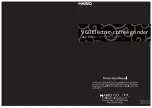
9
Installing or removing abrasive disc
(optional accessory)
NOTE:
• Use sander accessories specified in this manual.
These must be purchased separately.
Mount the rubber pad onto the spindle. Fit the disc on the
rubber pad and screw the sanding lock nut onto the
spindle. To tighten the sanding lock nut, press the shaft
lock firmly so that the spindle cannot revolve, then use the
lock nut wrench and securely tighten clockwise.
(Fig. 12)
To remove the disc, follow the installation procedure in
reverse.
Installing or removing dust cover
attachment (optional accessory)
WARNING:
• Always be sure that the tool is switched off and
unplugged before installing or removing the dust cover
attachment. Failure to do so causes damage to the tool
or a personal injury.
There are three types of dust cover attachment and each
is used in one of different positions.
(Fig. 13, 14 & 15)
Place the dust cover attachment so that the side of the
dust cover attachment with the marking (A, B or C) faces
towards the tool head. Snap the pins of the dust cover
attachment in the vent.
(Fig. 16)
Dust cover attachment can be removed by hand.
NOTE:
• Clean out the dust cover attachment when it is clogged
with dust or foreign matters. Continuing operation with
a clogged dust cover attachment will damage the tool.
OPERATION
WARNING:
• It should never be necessary to force the tool. The
weight of the tool applies adequate pressure. Forcing
and excessive pressure could cause dangerous wheel
breakage.
• ALWAYS replace wheel if tool is dropped while
grinding.
• NEVER bang or hit grinding disc or wheel onto work.
• Avoid bouncing and snagging the wheel, especially
when working corners, sharp edges etc. This can
cause loss of control and kickback.
• NEVER use tool with wood cutting blades and other
saw blades. Such blades when used on a grinder
frequently kick and cause loss of control leading to
personal injury.
CAUTION:
• Never switch on the tool when it is in contact with the
workpiece, it may cause an injury to operator.
• Always wear safety goggles or a face shield during
operation.
• After operation, always switch off the tool and wait until
the wheel has come to a complete stop before putting
the tool down.
• Always hold the tool firmly with one hand on housing
and the other on the side handle.
Grinding and sanding operation (Fig. 17)
Turn the tool on and then apply the wheel or disc to the
workpiece.
In general, keep the edge of the wheel or disc at an angle
of about 15° to the workpiece surface.
During the break-in period with a new wheel, do not work
the grinder in the B direction or it will cut into the
workpiece. Once the edge of the wheel has been rounded
off by use, the wheel may be worked in both A and B
direction.
Operation with abrasive cut-off/diamond
wheel (optional accessory) (Fig. 18)
As for the installation, follow the instructions for depressed
center wheel.
The direction for mounting the lock nut and the inner
flange varies by wheel thickness.
Refer to the table below.
(Fig. 19)
WARNING:
• When using an abrasive cut-off/diamond wheel, be
sure to use only the special wheel guard designed for
use with cut-off wheels. (In some European countries,
when using a diamond wheel, the ordinary guard can
be used. Follow the regulations in your country.)
• NEVER use cut-off wheel for side grinding.
• Do not “jam” the wheel or apply excessive pressure. Do
not attempt to make an excessive depth of cut.
Overstressing the wheel increases the loading and
susceptibility to twisting or binding of the wheel in the
cut and the possibility of kickback, wheel breakage and
overheating of the motor may occur.
• Do not start the cutting operation in the workpiece. Let
the wheel reach full speed and carefully enter into the
cut moving the tool forward over the workpiece surface.
The wheel may bind, walk up or kickback if the power
tool is started in the workpiece.
• During cutting operations, never change the angle of
the wheel. Placing side pressure on the cut-off wheel
(as in grinding) will cause the wheel to crack and break,
causing serious personal injury.
• A diamond wheel shall be operated perpendicular to
the material being cut.
Operation with wire cup brush (optional
accessory)
CAUTION:
• Check operation of brush by running tool with no load,
insuring that no one is in front of or in line with brush.
• Do not use brush that is damaged, or which is out of
balance. Use of damaged brush could increase
potential for injury from contact with broken brush
wires.
Unplug tool and place it upside down allowing easy
access to spindle. Remove any accessories on spindle.
Thread wire cup brush onto spindle and tighten with
supplied wrench.
(Fig. 20)
When using brush, avoid applying too much pressure
which causes over bending of wires, leading to premature
breakage.
Summary of Contents for 9564HR
Page 91: ...91 ...










































